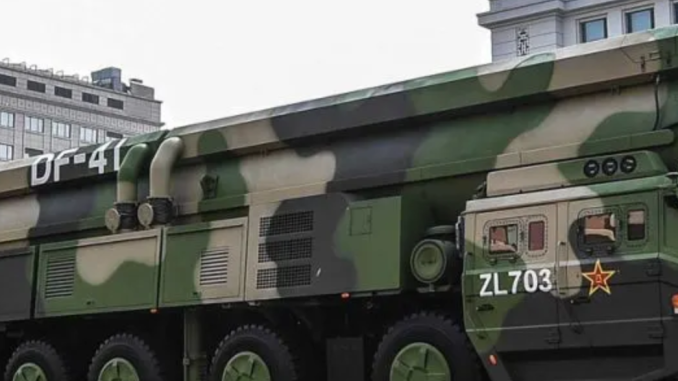
(Washington D.C.) The Pentagon’s just published report on China cites three Nuclear Ballistic Missiles capable of hitting the US mainland directly from China. The report, called “Military and Security Development Regarding the People’s Republic of China,” specifies the range of China’s CSS4 Mod2 Mod3 as having an ability to reach 13,000km.
Two other nuclear missiles cited in the report can also reach the US from China, the DF-41 and CSS 10 Mod 2 able to reach 12,000km and 11,200km respectively. The distance between Beijing and Los Angeles is 10,084km, placing California within direct reach of all three of these Chinese nuclear missiles. China is also developing a precision nuclear strike capability with its DF-26 medium range anti-ship ballistic missile able to travel as far as 2,000 miles. Added to this threat circumstance, the PRC is also building new ground silo ICBM fields which will cumulatively contain as many as 300 silos, the Pentagon report says.
These are just a few of the factors likely to have influenced the Biden Administration’s Nuclear Posture Review. The US refusal to embrace a “No First Use” nuclear declaratory policy in the recently published 2022 Nuclear Posture Review seems to make sense in light of the escalating global threat environment.
While the text of the Nuclear Posture Review report is clear to emphasize that nuclear weapons exist as a necessity for “deterrence” purposes and not as an operational “attack” option persay, the document does not rule out the possibility in “extreme circumstances.”
“As long as nuclear weapons exist, the fundamental role of nuclear weapons is to deter nuclear attack on the United States, our Allies, and partners. The United States would only consider the use of nuclear weapons in extreme circumstances to defend the vital interests of the United States or its Allies and partners,” the text of the NPR states.
The wording of the NPR document seems quite specific as it cites that there “remains a narrow range of contingencies in which nuclear weapons may still play a role.”
Certainly any consideration of an initial nuclear “attack” of any kind does not in any way align with the Pentagon’s strategic thinking, yet allowing for the full range of possibility does seem to strengthen a deterrence posture. This thinking, as outlined in the text of the NPR, explains that adopting a No First Use policy would present an “unacceptable level of risk.”
“We conducted a thorough review of a broad range of options for nuclear declaratory policy – including both No First Use and Sole Purpose policies – and concluded that those approaches would result in an unacceptable level of risk in light of the range of non-nuclear capabilities being developed and fielded by competitors that could inflict strategic-level damage to the United States and its Allies and partners,” the document states.
Given these circumstances, it is by no means surprising that the Pentagon NPR is clear to emphasize the ongoing modernization and enhancement of the US nuclear triad. There are several critical new systems emerging such as the nuclear-armed F-35A, Sentinel ICBM slated to deploy by the end of the decade and air-dropped, nuclear-armed cruise missile called the Long Range Standoff (LRSO) weapon. The Pentagon’s NPR calls for full funding of many critical elements of the nuclear triad to include the B-21, Sentinel and LRSO, among others.
“To deter large-scale attacks, we will field a modern, resilient nuclear Triad. To deter theater attacks and nuclear coercion of Allies and partners, we will bolster the Triad with capabilities that further strengthen regional deterrence, such as F-35A dual-capable fighter aircraft (DCA) equipped with the B61-12 bomb; the W76-2 warhead; and the Long-Range Standoff (LRSO) weapon,” the NPR states.
China’s Nuclear Ambitions
China’s massive and fast-paced push to add more nuclear weapons to its arsenal is fast changing the threat equation for U.S. leaders who see the country’s ongoing large-scale increase in Intercontinental Ballistic Missiles (ICBMs) as a very “destabilizing” event.
U.S. Air Force Secretary Frank Kendall says China’s move to add hundreds of new land-based, fixed ICBM silos amounts to their developing a “first-strike” capability.
China’s ICBMs
“Most of their weapons have been mobile ICBMs, so this is a very destabilizing move and I am not sure they understand the risk they are taking. Whether they intend it or not … their move creates a first-strike capability. If they continue down this path to increase their ICBM force, then that is a de facto first-strike capability,” Kendall told reporters at the Air Force Association Symposium.
Kendall may have been referring to an event described in August at the Space and Missile Defense Symposium by the Commander of U.S. Strategic Command Adm. Charles “Chaz” Richard.
“Only four months ago, commercial satellite imagery discovered what is accepted to nuclear missile fields in western China. Each has nearly 120 ICBM silos. Now these compliment and are added into what they already have,” Richard told an audience at the symposium in Huntsville, Alabama.
Sure enough, Richard’s mention of Chinese ICBM silos being detected by commercial satellites is something that aligns entirely with the information referred to by Kendall.
China’s clear ambition to massively expand its nuclear arsenal is something that has been on the Pentagon’s radar for some time, as it was cited as a serious concern last year in the Pentagon’s 2020 China Military Report.
Following the publication of this report, senior Pentagon weapons developers and experts added even more specificity and expansion metrics describing China’s ambitious nuclear weapons expansion.
“We do believe that over the next decade, that China is likely to at least double the size of its nuclear stockpile in the course of implementing the most rapid expansion and diversification of its nuclear arsenal in its history, China’s history,” Chad Sbragia, deputy assistant secretary of defense for China, told reporters last year according to a Pentagon transcript. “An ability to double the stockpile demonstrates a move away from their historical minimum deterrence posture.”
“No First Use” Policy
At the moment, China is known to have an official “no first use” policy with nuclear weapons. However that position does not appear to remain the case, Kendall explained.
“I am reacting to what they are doing, which is significantly increasing their nuclear force with silo-based ICBMs. Several years ago they made a decision to move in the direction of a much larger ICBM force. Policies are declarations of intent, but intent can change very quickly,” Kendall said.
Kendall’s concern about Chinese ICBMs aligns in several respects with the Pentagon’s 2020 China Report which adds that the number of Beijing’s ICBMs capable of threatening America will likely grow to 200 in the next five years. As an element of this expansion, China is increasing its inventory of long-range land-fired DF-26 Anti-Ship missiles able to fire both conventional and nuclear missiles. The Pentagon’s 2021 China report raises the concerning possibility that the People’s Liberation Army may well convert its well-known DF-26 “carrier-killer” anti-ship missile into a low-yield tactical nuclear weapon.
0 seconds of 3 minutes, 7 secondsVolume 90%
Video Above: Would the conflict over Taiwan escalate into a nuclear war between China and Taiwan?
This presents new threat dimensions given the range and scope of the weapon, which is widely reported to be capable of hitting large Navy surface platforms with precision guidance from ranges up to 2,000 miles.
DF-26 Missile
“The DF-26 is the PRC’s first nuclear-capable missile system that can conduct precision strikes, and therefore, is the most likely weapon system to field a lower-yield warhead in the near-term. PRC military writings in 2012 noted that the introduction of new precise small-yield nuclear weapons could possibly allow for the controlled use of nuclear weapons,” DoD’s 2021 “Report on Military and Security Developments involving the People’s Republic of China” states.
Discussion about the prospect of any kind of “limited” or “targeted” nuclear engagement using tactical, lower-yield weapons has received much attention in recent years following Russia’s violation of the INF Treaty and pursuit of low-yield nuclear weapons. These developments generated significant concern at the Pentagon and were likely part of the rationale for the Trump administration’s 2018 Nuclear Posture Review.
The Pentagon’s 2022 China report confirms that indeed China is developing a nuclear-capable DF-26.
The PLA Rocket Force’s DF-26 missiles during a military parade in Beijing in September 2015.
eurasiantimes.com
“The multi-role DF-26 is designed to rapidly swap conventional and nuclear warheads and is capable of conducting precision land-attack and anti-ship strikes in the Western Pacific, the Indian Ocean, and the South China Sea from mainland China,” the report states.
If merely a few nuclear weapons could unleash massive, unimagined devastation upon cities and even entire countries, why would any country need more than a small number of weapons in their arsenal?
In keeping with Ancient military philosopher Sun Tzu’s famous “Mass Matters” concept, Richard said, “it does not matter if your weapons are superior if you do not have enough of them.”
* Article from: Warrior Maven

